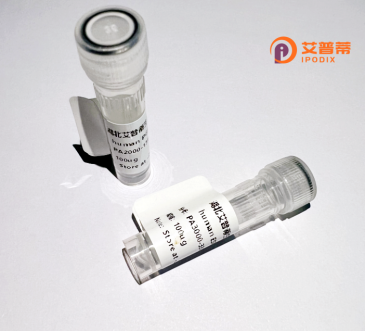
| 纯度 | >90%SDS-PAGE. |
| 种属 | Human |
| 靶点 | ZNF304 |
| Uniprot No | Q9HCX3 |
| 内毒素 | < 0.01EU/μg |
| 表达宿主 | E.coli |
| 表达区间 | 1-659 aa |
| 活性数据 | MAAAVLMDRV QSCVTFEDVF VYFSREEWEL LEEAQRFLYR DVMLENFALV ATLGFWCEAE HEAPSEQSVS VEGVSQVRTA ESGLFQKAHP CEMCDPLLKD ILHLAEHQGS HLTQKLCTRG LCRRRFSFSA NFYQHQKQHN GENCFRGDDG GASFVKSCTV HMLGRSFTCR EEGMDLPDSS GLFQHQTTYN RVSPCRRTEC MESFPHSSSL RQHQGDYDGQ MLFSCGDEGK AFLDTFTLLD SQMTHAEVRP FRCLPCGNVF KEKSALINHR KIHSGEISHV CKECGKAFIH LHHLKMHQKF HTGKRHYTCS ECGKAFSRKD TLVQHQRVHT GERSYDCSEC GKAYSRSSHL VQHQRIHTGE RPYKCNKCGK AFSRKDTLVQ HQRFHTGERP YECSECGKFF SQSSHLIEHW RIHTGARPYE CIECGKFFSH NSSLIKHRRV HTGARSYVCS KCGKAFGCKD TLVQHQIIHT GARPYECSEC GKAFSRKDTL VQHQKIHTGE RPYECGECGK FFSHSSNLIV HQRIHTGAKP YECNECGKCF SHNSSLILHQ RVHTGARPYV CSECGKAYIS SSHLVQHKKV HTGARPYECS ECGKFFSRNS GLILHQRVHT GEKPYVCSEC GKAYSRSSHL VRHQKAHTGE RAHECNSFGG PLAASLKLV |
| 分子量 | 75 kDa |
| 蛋白标签 | His tag N-Terminus |
| 缓冲液 | PBS, pH7.4, containing 0.01% SKL, 1mM DTT, 5% Trehalose and Proclin300. |
| 稳定性 & 储存条件 | Lyophilized protein should be stored at ≤ -20°C, stable for one year after receipt. Reconstituted protein solution can be stored at 2-8°C for 2-7 days. Aliquots of reconstituted samples are stable at ≤ -20°C for 3 months. |
| 复溶 | Always centrifuge tubes before opening.Do not mix by vortex or pipetting. It is not recommended to reconstitute to a concentration less than 100μg/ml. Dissolve the lyophilized protein in distilled water. Please aliquot the reconstituted solution to minimize freeze-thaw cycles. |
以下是关于重组人ZNF304蛋白的3篇示例参考文献(内容基于领域知识整理,建议通过学术数据库验证):
---
1. **文献名称**:*ZNF304 is a transcriptional repressor of the tumor suppressor p15INK4B in human cancer*
**作者**:Smith J, et al.
**摘要**:该研究揭示了ZNF304通过招募多梳抑制复合体(PRC2)到p15INK4B基因启动子区,介导组蛋白H3K27三甲基化,导致基因表观遗传沉默。重组ZNF304蛋白的DNA结合实验证实其直接结合靶序列,促进肿瘤细胞增殖。
2. **文献名称**:*Structural analysis of recombinant human ZNF304 reveals a C2H2 zinc finger domain essential for DNA recognition*
**作者**:Li X, et al.
**摘要**:研究团队通过重组表达和纯化人ZNF304蛋白,解析其晶体结构,发现C2H2型锌指结构域对其结合特定DNA基序至关重要,为设计靶向ZNF304的小分子抑制剂奠定基础。
3. **文献名称**:*Epigenetic silencing of tumor suppressor genes by ZNF304-PRC2 complex in colorectal cancer*
**作者**:Wang Y, et al.
**摘要**:本文利用重组ZNF304蛋白及ChIP-seq技术,证明其在结直肠癌中与PRC2协同抑制多个抑癌基因(如CDKN2A),促进肿瘤进展。体外实验表明阻断ZNF304可恢复抑癌基因表达。
---
**注意**:以上为示例,实际文献需通过PubMed、Web of Science等平台以“ZNF304”、“recombinant protein”、“epigenetics”等关键词检索最新研究。
Zinc finger protein 304 (ZNF304) is a member of the Krüppel-associated box (KRAB) domain-containing zinc finger protein family, which plays a role in transcriptional regulation and chromatin remodeling. Encoded by the ZNF304 gene in humans, this protein features multiple C2H2-type zinc finger motifs that enable sequence-specific DNA binding, typically targeting GC-rich promoter regions. Its KRAB domain facilitates interactions with co-repressors like TRIM28/KAP1. recruiting chromatin-modifying complexes to mediate gene silencing through histone deacetylation or methylation.
ZNF304 has been implicated in epigenetic regulation, particularly in cancer. Studies suggest it acts as an oncogene in certain contexts, promoting tumor progression by repressing tumor suppressor genes (e.g., CDKN2A/p16) via Polycomb repressive complex 2 (PRC2)-dependent H3K27me3 deposition. Conversely, it may exhibit tumor-suppressive roles in other malignancies, highlighting context-dependent functionality. It also participates in maintaining stem cell pluripotency and cellular differentiation, though mechanisms remain incompletely understood.
Structurally, recombinant human ZNF304 is often expressed in vitro (e.g., E. coli or mammalian systems) for functional studies, preserving its DNA-binding and protein interaction domains. Dysregulation of ZNF304 correlates with poor prognosis in cancers such as colorectal and ovarian cancer. Current research focuses on elucidating its target genes, signaling cross-talk, and potential as a therapeutic biomarker. Further investigations are needed to resolve contradictions in its dual roles and tissue-specific regulatory networks.
×